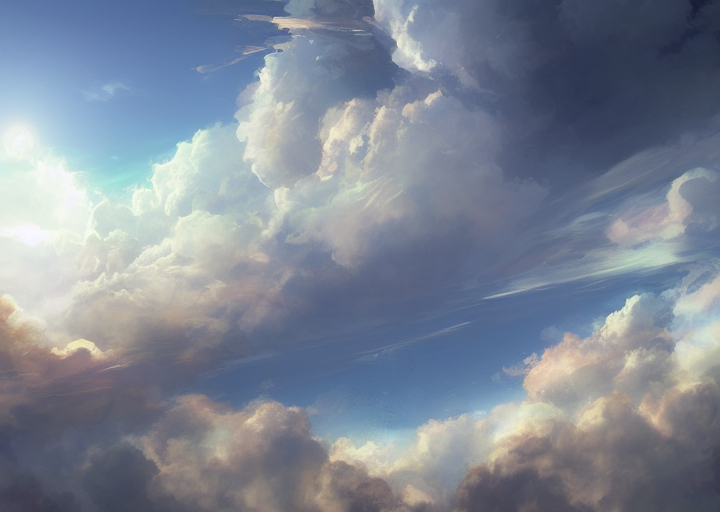Firmament
The firmament separates Domos and the Monumidium. To mortals on the land looking up, it looks like a blue dome during the day and a black dome during the night. It contains all air and clouds, and has only been reached once in known history. But before it was reached, during the Relict Age, the firmament was a dense layer of dark clouds which kept out most of the divine light from the realms above. When Hrememun tore a hole in the firmament from the top of the Tower of Ubrem, the tower fell, Hrememun died, and the hole became the sun. The land was not accustomed to direct divine light, and so this event was called the Enlightenment.
During the Young World, the firmament still remained, but a day-night cycle had begun. This is because the realm of Celestium swirls between Domos and Astrium like a never ending whirlpool. Because Celestium is most dense around the sun, it is day near the sun, and night farthest from the sun. During the night, Celestium is so thin that phenomena from the void of Astrium can be observed, and constellations formed by the Celesvena of the Eah also stand out against the darkness.
During the day, the following phenomena can be seen:
- The sun, often called the Radiant Rift, which is a hole in the firmament from which concentrated divine light pours out. It brings day wherever it goes, and encircles the lands with mathematical predictability.
- The stars that make up constellations, each one an Eah who dwells in the Monumidium. The stars move often, the only indication of life above the firmament. Because of the movement of the stars, using them to navigate is often difficult, but there are methods that utilise Celestial Almanacs. Additionally, there are waypoints made up of consistent constellation clusters that sailors can use to help find their bearing.
- The dark moon, known as the Void Moon, whose presence is only known because a great round darkness sometimes covers large areas of stars and slowly moves across the night sky, making slow changes in direction as it goes. It is almost universally feared by cultures across Ebdypha, and is often seen as a bad omen. Even in secular cultures, the dark moon instills fear in sailors because it makes navigating using the stars nigh impossible. No reliable pattern in its movements or appearances has been determined, though it is sometimes associated with colder weather. Sometimes it passes behind the moon, but sometimes it shifts in front of the moon, which makes the night incredibly dark and dependent on starlight.
- The moon, known as Alaeia's Comet, which usually appears as a dim tear-shape in the day, and as a comet with a long tail that stretches across the sky during the night. When at its closest, the tail shimmers with iridescence, and rainfall during these times often glistens with many colours. The times when the moon and tail are close enough for the colours to be seen is known as a Alaeia's Tears. The moon only appeared around 2000 years ago, when the Seasonal age began.
- Monuments, which are areas where the firmament was scarred by the Enlightenment, and divine light constantly pours out. These areas always look as bright as daylight.



Comments